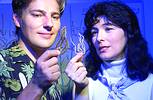Study of remarkable optics in marine creatures may help development of microlenses for optical networks
24 October 2001
News

Scientists from Bell Labs have discovered that chalk-like calcite crystals in the skeletons of marine creatures known as brittlestars have a remarkable dual function, acting as armour, as well as optical receptors for an all-seeing compound eye. They say that studies of this novel multifunctional biomaterial may lead to better-designed optical elements for telecommunications networks.
The surprising discovery that brittlestars use calcitic crystals to act as optical detectors, in addition to providing skeletal support, was made by an international multidisciplinary team of researchers. "This is an excellent example of something we can learn from nature," said Federico Capasso, Physical Research Vice President at Bell Labs. "These tiny calcite crystals are nearly perfect optical microlenses, much better than any we can manufacture today."
Brittlestars, also known as serpent stars, are marine invertebrates that usually have five thin long arms emanating from a small, disk-shaped body. The analysis of bony structures in the arms showed the presence of a regular array of spherical microstructures that look like lenses. Experiments subsequently showed that these micro structures, which are absent in closely-related but light-indifferent species of brittlestars, were sophisticated optical elements that have the optimal design for focusing light.
The lenses focus light about 5 mm below their surface. Nerve bundles running through the skeleton underneath the lenses are thought to pick up the light signal. Acting together, thousands of calcite crystals form a kind of primitive compound eye that covers much of the organism's body. The calcite microlenses expertly compensate for birefringence and spherical aberration - physical effects common in lenses that distort light - and scientists hope to mimic nature's success and design microlenses based on the brittlestar model.
Such biomimetic lenses may prove useful as components of optical networks, and in chip design, where they could potentially improve optical lithography techniques. "Biomimetics builds on nature's expertise," said John Rogers, Director of Nanotechnology Research at Bell Labs. "In this case, a relatively simple organism has a solution to a very complex problem in optics and materials design."
www.bell-labs.com
Further reading:
Electronic News Digest
News
A brief synopsis of current global news relating to the electronic engineering fields with regards to company finances, general company news, and engineering technologies.
Read more...
4000 A containerised DB for power project
News
Power Process Systems has successfully completed the design, fabrication, and commissioning of a 4000 A containerised distribution board for a wind/PV solar hybrid renewable energy project.
Read more...
Datacentrix Industrial Indaba 2025
News
Datacentrix recently hosted its inaugural Industrial Indaba 2025, where industry leaders explored how digitalisation, resilience, security and compliance are shaping the future of sustainable industrial operations in Africa.
Read more...
RS brings solar light to 150 000 people
RS South Africa
News
The company’s three-year partnership with SolarAid aims to raise £1 million through corporate donations, matched funding, product contributions, and fundraising to accelerate access to safe, sustainable energy.
Read more...
Microchip and AVIVA Links collaboration
Altron Arrow
News
Microchip and AVIVA Links have achieved groundbreaking ASA-ML interoperability, accelerating the shift to open standards for automotive connectivity.
Read more...
World’s leading supplier of grid automation products
News
Hitachi Energy was recognised as the global market share leader in grid automation for electric power transmission and distribution utilities by ARC Advisory Group.
Read more...
Vivashan Muthan appointed as head of export sales and operations at RS South Africa
RS South Africa
News
With a career spanning engineering, business development, and sales leadership across sub-Saharan Africa, Vivashan Muthan brings a wealth of expertise to his new role as head of export sales and operations.
Read more...
Google equips university students across Africa with free access to advanced AI tools
News
A 12-month Google AI Pro plan has been launched for students in Ghana, Kenya, Nigeria, Rwanda, South Africa, and Zimbabwe to build foundational AI skills.
Read more...
Africa’s space economy projected to be worth $22,6 billion in 2026
News
South Africa is gearing up to be at the forefront of the growth in the space industry, creating thousands of jobs, driving innovation, and boosting the national economy.
Read more...
Distribution partnership with MacDermid Alpha
Testerion
News
MacDermid Alpha Electronics Solutions India Private Limited has announced that as of 01 September 2025 Testerion will be the sole importer and distributor of their products to the South African market.
Read more...


